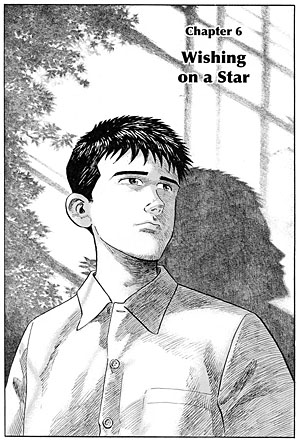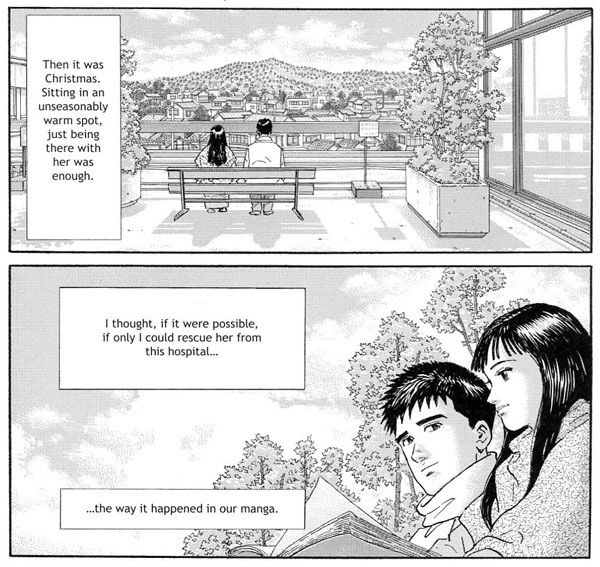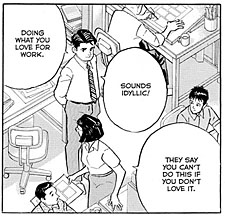 By Jiro Taniguchi
By Jiro Taniguchi
232 pages, black and white
Published by Fanfare/Ponent Mon
I appreciate talented creators who have a wide range of styles, and Jiro Taniguchi definitely falls into that category. From the nail-biting tense mystery of Summit of the Gods, to the quiet and contemplative Walking Man, each new Taniguchi project is slightly different than the previous. A Zoo in Winter is his latest book to be translated into English, and it’s a loosely autobiographical book about Taniguchi’s early life and how he became a manga artist. It’s more A Drifting Life than Bakuman, and it makes me already hoping for a sequel.
 Taniguchi uses a stand-in named Hamaguchi for himself, opening in December 1966 as he works in deliveries for a fabric wholesaler while hoping to break into a design position. As we watch him fumble through interactions with the boss’s daughter Ayako and his co-workers, it’s instantly obvious to the reader what a horrible match this job is for Hamaguchi. It’s a relief when the job goes sour and he finds himself needing to start looking elsewhere, needless to say, and that’s how we get Hamaguchi as a manga assistant to a creator. Even more so than Bakuman, A Zoo in Winter emphasizes the strange mixture of frantic pace and going nowhere nature of a manga assistant. Hamaguchi is forever being thrown into situations he’s not prepared for—both professional and personal—and it’s a reminder that this isn’t just an art form but also an industry.
Taniguchi uses a stand-in named Hamaguchi for himself, opening in December 1966 as he works in deliveries for a fabric wholesaler while hoping to break into a design position. As we watch him fumble through interactions with the boss’s daughter Ayako and his co-workers, it’s instantly obvious to the reader what a horrible match this job is for Hamaguchi. It’s a relief when the job goes sour and he finds himself needing to start looking elsewhere, needless to say, and that’s how we get Hamaguchi as a manga assistant to a creator. Even more so than Bakuman, A Zoo in Winter emphasizes the strange mixture of frantic pace and going nowhere nature of a manga assistant. Hamaguchi is forever being thrown into situations he’s not prepared for—both professional and personal—and it’s a reminder that this isn’t just an art form but also an industry.
At the same time, A Zoo in Winter isn’t just about how Hamaguchi becomes a manga artist, it’s about how Hamaguchi progresses from a boy to a man. Until Hamaguchi leaves the wholesaler, he’s just fumbling through life, slightly adrift. Not only does becoming a manga assistant give him purpose, it strengthens his character. When Hamaguchi’s brother visits, the brother admits that he feared the worst but was pleasantly surprised with what he found. The insinuation is clear that he’s become more responsible since last seen, that he’s turned what could be a weak or nothing position and turned into one that holds that much more. And when he meets Mariko, he learns a lot from her on how to deal with people, how to have a budding romantic relationship, and how to push forward in life and strive hard. Sure, he has some bumps along the way (like his first time drinking or being out with a woman), but as a coming-of-age story it’s a pleasant journey.
A Zoo in Winter also does a good job with fleshing out the other assistants, especially Moriwaki and Fujita. Each ultimately turns into a different path that Hamaguchi could go down; the former someone who struck out on his own and eventually came back to be an assistant forever, the latter getting the big chance in his hands and then fumbling it. Watching their experiences ultimately push Hamaguchi forward into getting his own work done ends up feeling real rather than forced, and even slightly inspirational. People who are aspiring creators of any artistic medium might find it hard to keep from getting a renewed sense of purpose after reading A Zoo in Winter.

 The one constant in all of Taniguchi’s works is his amazing art, and A Zoo in Winter is no exception to that rule. His people are beautiful, with delicate lines coming together to form their figures in ways that look realistic and gentle. From the chapter portraits that open each section of the book to the individual panels of characters, there’s always a lot of attention and care put into every single drawing. Just as impressive are his settings, though; the primary location of A Zoo in Winter is the manga studio, and Taniguchi manages to both draw it as being close quarters, but never visually so cramped that you are lost. The rest of the locations are equally well drawn, from bars to streets to apartments, and of course the titular zoo with its wide open spaces and possibilities.
The one constant in all of Taniguchi’s works is his amazing art, and A Zoo in Winter is no exception to that rule. His people are beautiful, with delicate lines coming together to form their figures in ways that look realistic and gentle. From the chapter portraits that open each section of the book to the individual panels of characters, there’s always a lot of attention and care put into every single drawing. Just as impressive are his settings, though; the primary location of A Zoo in Winter is the manga studio, and Taniguchi manages to both draw it as being close quarters, but never visually so cramped that you are lost. The rest of the locations are equally well drawn, from bars to streets to apartments, and of course the titular zoo with its wide open spaces and possibilities.
My one complaint with A Zoo in Winter is the ending, or rather, the point in which it stops. It feels like there’s still so much more to be told, even as you can see where Hamaguchi’s life will go from there. It says a lot about the book that even though you know what would happen next, you still want to see more. If Taniguchi ever does decide to tell more stories with A Zoo in Winter, I know I’ll be eagerly reading. Somehow, I suspect I’m not the only one.
Purchase Links: Amazon.com | Powell’s Books
